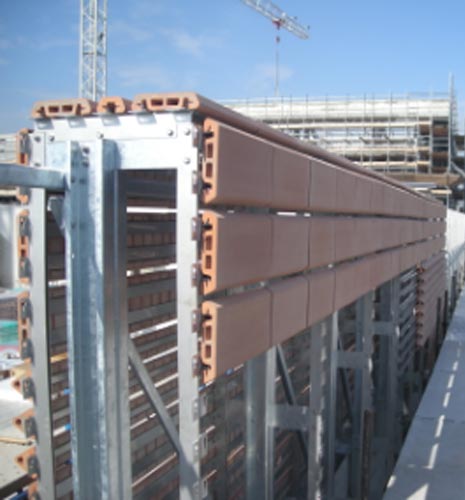Cladding
Internal wall structure
This technical element (in the matter of load bearing or curtain walls) is formed by a continuous 2-dimension- al surface, useful for the mechanical fixing of the outer layer of cladding. The specific constitution of the wall structure is one of the factors that influences the choice of fixing device. Generally speaking, the most recurrent solutions of wall structure can be classified as follows: - traditional walls (in brick, stone, or mixed) to be restored and functionally improved using the cavity wall solution; - load bearing walls in small elements of modern conception (made with solid brick, perforated brick or concrete blocks); - continuous walls in concrete; - curtain walls created by filling in the spaces between the reinforced concrete framework (generally the most recurrent, at least in Italy). In this case, the mechanical devices supporting the external cladding are anchored to the beams and columns of the framework rather than to the actual curtain walls.
Onto the wall structure a 1-2 cm thick layer of plaster is then applied to consolidate and smoothen the surface on which to apply the layer of insulating material, normally present in the technical solution of the cavity wall. The insulators used for curtain walls can essentially be divided into three categories: - insulators of mineral origin; - insulators of vegetable origin; - insulators of synthetic origin. The insulating panels can be fixed after having ensured the correct execution of the regularisation layer. Here, great care must be taken to avoid the adhesive getting in the joints between panels, with the consequent interruption of the insulator; moreover, in the case of mechanical fixing, the fixing elements should be plastic so as not to create cold bridges. Mechanical fixing is particularly apt when redesigning façades, since adhesive cannot guarantee perfect adhesion on irregular surfaces, degraded by weather and atmsopheric agents. The layer of insulation - with the function of raising thermal insulation capacities - adequately fixed to the wall structure with adhesives and, if necessary, metal dowels, should not be hydrophilic (in order to avoid water absorption that can pass through the joints of the external cladding which would compromise its qualities), but should transpire sufficiently and be fire-resistant.This insulating layer (with a thickness ranging between 3 and 7 cm) can be made in a variety of materials, each with different characteristics and costs, such as panels reinforced with mineral fibres or fibreglass and panels in cork, polystyrene, polyurethane, etc. The layer of insulation presents points of discontinuity in correspondence with the metal structural frame (essential for the support and trans- fer of load from the external cladding to the wall structure). Clearly, in these points, cold bridges are created between interior and exterior, therefore it is important to choose a solution which reduces to a minimum the number of interruptions in the insulating layer.



